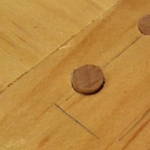We may receive a commission when you use our affiliate links. However, this does not impact our recommendations.
By Norman Reid
Design has always been one of my biggest challenges in woodworking. To be frank, I didn’t know how to create my own designs. I’m always amazed by the innovative designs of other woodworkers, but aside from copying, creating my own seemed beyond my capacity. How would I begin to create a vision? Where would I get ideas? And how might I create something that is coherent, makes sense, has “style”?
I faced this very challenge in building the Greene & Greene pantry shelf for the August 2017 issue of Popular Woodworking. Not knowing how to start, I searched my library of woodworking books for something I could copy, my then-standard design methodology. I found one example that used retaining rods to hold cans on its shelves. While I liked that feature, I otherwise thought the shelf lacking in style. Wanting something more, I decided to turn that design into something more to my taste.
I started out with the functional requirements in mind: It needed shelves – about five seemed right, varied in height to fit different-sized cans and boxes. I wanted retaining rods to keep the goods from tumbling to the floor. It needed to be a size and shape that would fit on the back of my pantry door, its intended destination. With these features in hand, I had my functional objective.
Now for dimensions. I decided to use whole-number proportions, as advocated so convincingly by Jim Tolpin and George Walker. I settled on a 2:3 ratio for the main case: 24″ X 36″. I added top and bottom decorative rails, each 3″ high, as punctuation. This gave me the proportions for the piece.
Then, with the functions and shape established, I considered how to build in some style. I’ve always liked the harmony and freshness of the Greene & Greene style and decided to apply it. The Greene & Greene idiom includes many elements that are variably applied across its many exemplars. I chose to use some of the more familiar ones: reveals, cloudlifts, ebony plugs and inlays and finger joints.
The result, I think, was a success. Rather than hang the shelf on the back of the pantry door where it would be hidden from view, my wife and I decided it merited a prominent position on the kitchen wall.
Building the shelf taught me an important lesson: that the ability to develop my own designs lies within me. Unwittingly, perhaps, I had established a methodology for creating interesting and possibly unique designs for pieces yet to be built.
My methodology is a three-step process. First, I’ll establish the functional requirements for the piece, be it a table, chair or casework. What is it meant to do and what features does it need to incorporate to accomplish its function? Second, I’ll develop harmonious proportions and apply them to the functional design. Whole-number proportions are a good starting point, though alternatives such as the Fibonacci number are worth considering when appropriate. Then, with the functions and proportions established, I’ll apply a design idiom. There are many choices besides Greene & Greene: Arts & Crafts, Shaker, Chippendale and Queen Anne come to mind, among many others.
This three-step methodology will take me a long way toward creating pieces that satisfy my desire to build interesting furniture. But even so, because it relies on existing idioms for stylistic treatment, it’s still limiting. What if I want to take my designs to the next level and create my own idiom? Where can I look for inspiration, for potential design elements? One source is natural forms, such as the curvature of petals, leaves or limbs. Another is the proportions and shapes of the human body. Architectural and design movements from the past, such as Art Deco and Art Nouveau, are another source.
The Greene & Greene pantry shelf project taught me a lot. All along, I’d been thinking of creativity as a light bulb suddenly illuminating the dark. But it’s not. It’s clear to me now that creativity is a process. My experience in designing the pantry shelf led me to formulate a set of step-by-step rules I can follow to pursue creativity. Now a whole world of new possibilities lies before me. What can I design and build next? I can hardly wait to get started.
By Norman Reid – woodworker, writer, and woodworking instructor living in Virginia’s Blue Ridge Mountains with his wife, a woodshop full of power and hand tools and four cats who think they are cabinetmaker’s assistants. He is co-owner of Shenandoah Tool Works and the author of “Choosing and Using Handplanes: All You Need to Know to Get Started Planing by Hand.”
Here are some supplies and tools we find essential in our everyday work around the shop. We may receive a commission from sales referred by our links; however, we have carefully selected these products for their usefulness and quality.










